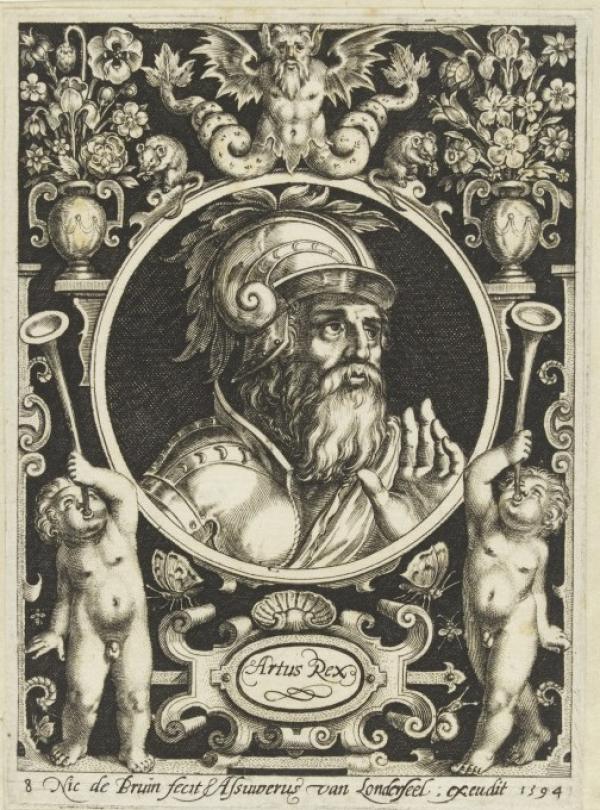A number of ornament engravings in the V&A collection dating to the 16th- and 17th centuries by Dutch and Flemish printmakers including Nicolaes de Bruyn, Anton Wierex, Jan Sadeler, and Theodor de Bry incorporate still life motifs.

V&A inventory number 24359.9
Theodor de Bry, Mustapha Bassa, Illustration to ‘Vitae et icones Sultanorum turcicorum’ by Jean-Jacques Boissard, 1596
Still life refers to the representation of a wide variety of inanimate objects, from food stuffs such as fruit or game, through to flowers, plants, insects and birds. The earliest known still lifes are the sculpted and painted representations of food offerings to the dead found in Ancient Egyptian tombs such as the tomb of Menna in Thebes from about 1422-1411 BC.
The tradition of depicting still life continued in the classical world, where attention to naturalistic detail was highly regarded. The Roman author Pliny the Elder (23-79 AD) describes how this genre played an important role in the famous competition between the ancient Greek painters Zeuxis and Parrhasius, which was held in about 400 BC, to establish who was the greater artist. In his Naturalis Historia, Pliny the Elder tells how Zeuxis painted grapes that were so lifelike that birds flew down to try and eat them; Parrhasius then painted a curtain over this work. When Zeuxis then attempted to lift this image of a curtain to reveal his own work it was proved that Parrhasius had the greater talent as his painting had fooled a human.

V&A inventory number 127K-1873
Unknown artist, Bird with cherries, fresco decoration from Pozzuoli, Italy, 200 AD
By the fifteenth century many artists began to incorporate interior settings and still life elements in religious paintings. At about this time independent still life schemes also start to be used for the borders of illuminated manuscripts produced in northern Europe, particularly in France and the Netherlands.

V&A inventory number 9002B
Unknown artist, Cut out decorated initial A, Southern Netherlands, about 1520.
This cutting of a border and initial A from an Antiphonar is decorated with carnations, violets, butterflies and bees. The minutely observed flowers and insects are characteristic of miniature painting that was emerging in Northern Europe at the end of the fifteenth century.

V&A inventory number 24913.8
Nicolaes de Bruyn, Portrait of King Arthur set within an ornamental frame, from a suite of 12, Antwerp, 1594
This print of King Arthur from a suite of 12 portraits of kings and heroes by Nicolaes de Bruyn and published by Assuerus van Londerseel also incorporates flowers into its ornamental border. As with the cutting from the illuminated manuscript, de Bruyn represents flowers, here displayed in two vases, in exquisite detail, allowing us to identify various types including the poppy, iris and fritillary.
Like Nicolaes de Bruyn, by the end of the sixteenth century many Dutch and Flemish printmakers began introducing still life motifs into their ornament engravings. This was possibly in response to a growing fashion for paintings in the genre by artists including Jan Snyders, Jan Davidsz de Heem, and Willem Kalf.

V&A inevntory number 24799:4
Justus Sadeler, Still life of flowers, fruit, birds and insects, Venice, 1500-1520
Here Sadler combines different types of fruit, vegetables, birds and fish grouped around a central vase of flowers. This presentation, emphasizing the luxurious variety of food stuffs, vessels and animals anticipates that employed in Still Life with Fruit, a Parrot and Polecat Ferrets by John Paul Gillemans, produced a century later.

V&A inventory number 513-1870
Paul Gillemans, Still Life with Fruit, a Parrot and Polecat Ferrets, mid 17th century
Prints often incorporate still life motifs into ornamental borders such as in this print by Theodor de Bry from his suite of 94 plates entitled ‘Emblemata Nobilitati’.

V&A inventory number 13673.12
Theodor de Bry, plate from a suite of 94 plates entitled Emblemata Nobilitati, Germany or the Netherlands, 1592-3
Here de Bry’s minutely observed flowers, birds and insects are combined to create an opulent frame around the central plate of the print. Born in Liège in modern day Belgium, Theodor de Bry worked predominantly in Strasbourg and Frankfurt am Main. He is documented in England between 1586 and 1589 where he made engravings after watercolours of the New World by Jacques Le Moyne de Morgues and John White.

V&A inventory number AM.3267BB-1856
Jacques Lemoyne de Morgues, A Wild Strawberry and a Female Emperor Moth, watercolour on paper, ca.1575
Water colour studies survive by Jacques Le Moyne de Morgues of plants and insects such as this study of A Wild Strawberry and a Female Emperor Moth. The careful observation of plant and insect in both this watercolour and the border of de Bry’s print raises questions on whether the engraver may have seen these watercolours and drawn inspiration from them for his own work.

V&A inventory number E.2664-1928
Marten de Vos and Anton Wierix II, The Deposition, from a suite of 22 plates illustrating The Life of Christ
Whilst providing appropriate borders and settings for prints such as The Life of Christ published by Martin de Vos, still life motifs can also be found incorporated into the ornamentation of objects from the seventeenth century.

V&A inventory number E.2654-1910
Theodor de Bry, designs for knife handles with allegorical figures symbolising the virtues of Hope and Fiedlity, Germany or the Netherlands, 1570-1580
In these designs for knife handles by Theodor de Bry vertical friezes of plants and animals appear to grow out from vases at the bottom of the designs to the oval frames surrounding the figures of Hope and Fidelity.

V&A inventory number 27857.5
Hans Collaert, Plate from a suite of 10 designs for pendants, Antwerp, 1573
Similarly this design for a pendant is ornamented with a vase holding two tulips in the centre, surrounded by scrolling foliage and flowers.